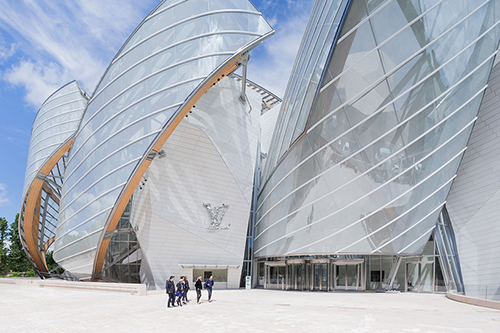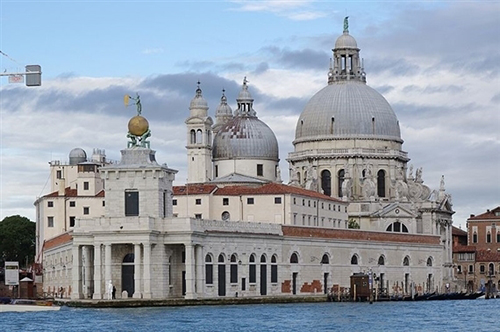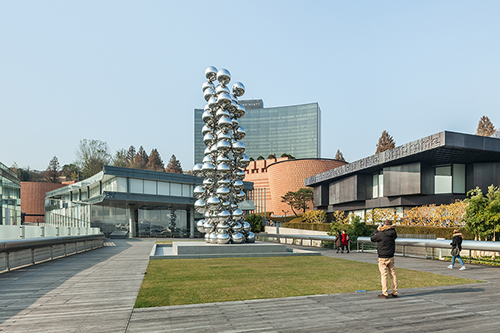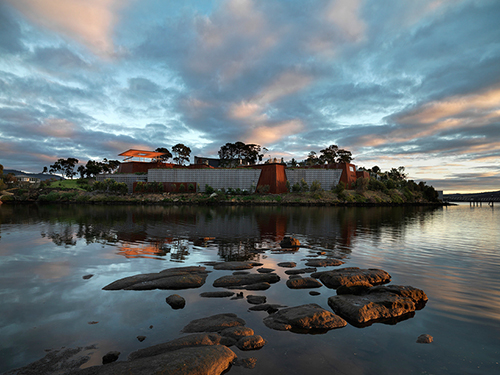Inside the World’s Top Private Collections of Contemporary Art
As The Marciano Foundation opens in Los Angeles, we look at 11 exceptional private collections open to the public — from a chain of art malls to a museum built into a rock face
Unpacking: The Marciano Collection, installation view. Courtesy the Marciano Art Foundation.
Photo: Robert Wedemeyer.
The private collection-turned-public museum may not be a new phenomenon, but it is one that keeps growing. According to a recent report on private art museums, over 300 collections worldwide are publicly accessible — with over 70% of all private museums having opened since 2000.
With so many private museums holding blue-chip contemporary art, how they distinguish themselves can have less to do with the art in their collections than their amenities, architecture, or location: Private museums grab headlines with splashy new buildings by ‘starchitects’, or impressive renovation projects that transform historic industrial buildings.
Beyond their often-impressive exteriors, however, each private museum also functions as an extension of its founder’s personality and taste — both in how its collection is presented, and how it engages with the surrounding community. We uncovered 11 private collections worth knowing, starting with an in-depth look at the new Marciano Art Foundation:
1. The Marciano Art Foundation, Los Angeles. Founders: Paul and Maurice Marciano
Lizzie Fitch, Ryan Trecartin, Ledge, 2014. Courtesy the Marciano Art Foundation. Photo: Robert Wedemeyer.
The Building: The new kid on the block is Los Angeles’ Marciano Art Foundation, which opened 25 May, and houses the contemporary art collection of brothers and Guess co-founders Paul and Maurice Marciano.
The Foundation has been established in a former Scottish Rite Masonic Temple, built in 1961, and retains many of the original Masonic symbols and mosaics, which invest the space with an unexpected sense of mysticism. Visiting art buffs will recognize it as the setting of the movie Ledge by artists Ryan Trecartin and Lizzie Fitch, filmed here at the Marciano’s behest.
Marciano Art Foundation sculpture garden. Courtesy the Marciano Art Foundation. Photo: Robert Wedemeyer.
The Collection: Featuring over 1,500 works by more than 200 artists, the Marciano collection is about as contemporary as it gets, focusing on art made since 1990. Its inaugural exhibition, Unpacking, curated by Philipp Kaiser, includes major site-responsive installations and a solo exhibition of Los Angeles artist Jim Shaw. Visitors will also encounter a mural-sized work by Takashi Murakami and a Paul McCarthy sculpture that takes inspiration from a Jeff Koons Balloon Dog — echoing the inaugural exhibition of another recently opened private museum in Los Angeles, The Broad.
But does Los Angeles need another private collection on public display? If ticket sales are any indicator, the answer is yes. Like The Broad, The Marciano Art Foundation is free to visit if you book ahead. Demand for advanced tickets, however, has quickly outstripped supply; those for the months of May and June have already sold out.
2. The Broad, Los Angeles. Founders: Eli and Edythe Broad
Visitors at the entrance line at The Broad. Photo: Ryan Miller.
The Building: Designed by Diller Scofidio + Renfro, The Broad is an architectural jewel in the heart of downtown Los Angeles, featuring a unique latticework exterior and vault-like interior, .
The Collection: The collection, which includes over 2,000 works of art, reads like a who’s who of blue chip postwar and contemporary art, with particularly strong holdings of works by Jeff Koons, Cy Twombly, Joseph Beuys, and Cindy Sherman.
3. Zabludowicz Collection, London. Founders: Poju and Anita Zabludowicz
The exterior of London’s Zabludowicz Collection.
The Building: The Zabludowicz Collection is housed in a restored former Methodist chapel in north London.
The Collection: One of the world’s strongest collections of contemporary art, the Zabludowicz features works by both emerging and established artists, including Francis Alÿs, Goshka Macuga, and Haegue Yang.
4. Sammlung Boros, Berlin. Founders: Christian and Karen Boros
Katja Novitskova, installation view, Boros Collection. Photo: © NOSHE.
The Building: A former Nazi bunker — and former sex club — the Boros Collection has perhaps the most storied setting of any private collection, providing a unique context for the art on display.
The Collection: Exhibitions are hosted every four years, and can be accessed only via scheduled tours. The current display features artists including Martin Boyce, He Xiangyu, Yngve Holen.
5. Rubell Family Collection, Miami. Founders: Donald and Mera Rubell
The Rubell Family Collection in Miami, Florida
The Building: Located in a repurposed Drug Enforcement Agency building since 1993, the Rubell Family Collection will soon move to a 2.5-acre campus in Miami’s Allapattah District, designed by Selldorf Architects.
The Collection: One of the most prominent and respected private collections of contemporary art, the Rubell contains works by Jean-Michel Basquiat, Yayoi Kusama, Kara Walker, and many others.
6. Fondation Louis Vuitton, Paris. Founders: Bernard Arnault, LVMH
Fondation Louis Vuitton. Photo: Iwan Baan.
The Building: Designed by Frank Gehry, the Fondation Louis Vuitton resembles a glass sailboat, planted in the middle of Paris’s Bois de Boulogne.
The Collection: The collection contains works by Gerhard Richter, Christian Boltanski, Pierre Huyghe, and others, as well as commissions by artists like Ellsworth Kelly, Taryn Simon, and Olafur Eliasson.
7. Pinault Collection, Venice. Founder: François Pinault
Venice’s Punta della Dogana, which, along with the historic Palazzo Grassi, is home to the Pinault Collection, Venice.
The Building: Currently housed in Venice’s historic Palazzo Grassi and Punta della Dogana, an imminent move will find the Pinault Collection relocated to Paris’s Les Halles in the old Bourse de Commerce.
The Collection: A luxury goods magnate and the owner of Christie’s, Pinault has amassed a collection of over 3,000 works of art by artists including Richard Serra, Agnes Martin, and Andy Warhol.
8. Leeum, Samsung Museum of Art, Seoul. Founders: Lee Byung-chull, Samsung Group
Leeum Exterior. Courtesy of Leeum, Samsung Museum of Art. Photo: Kyung Sub Shin.
The Building: The Leeum is made up of three museums: one devoted to Korean traditional art, designed by Mario Botta; the second, designed by Jean Nouvel, dedicated to modern and contemporary art; and a children’s center, designed by Rem Koolhaas.
The Collection: The Lee family collection holds Korean national treasures, as well as a trove of post-war international art, by artists like Damien Hirst and Andreas Gursky, and important Korean artists Kim Whanki, Nam June Paik, and Do Ho Suh.
9. Centro de Arte Contemporânea Inhotim, Brumadinho, Brazil. Founder: Bernardo Paz
Inhotim sits nestled in a lush Botanic garden in Brumadinho, Minas Gerais, Brazil.
The Building: Inhotim is located in a spectacular complex of pavilions and gardens, fusing nature and contemporary art.
The Collection: The collection presents site-specific permanent installations by artists including Doris Salcedo, Matthew Barney, and Lygia Pape, as well as strong holdings of works by Brazilian artists Tunga, Rivane Neuenschwander, Cildo Meireles, and international artists including Pipilotti Rist, and Paul McCarthy.
10. MONA, Museum of Old and New Art, Hobart, Tasmania. Founder: David Walsh
MONA, Museum of Old and New Art. Image courtesy of MONA Museum of Old and New Art, Hobart, Tasmania, Australia. Photo: MONA/Rémi Chauvin.
The Building: A massive museum built into a rock face, designed by Fender Katsalidis Architects, some of the galleries have raw sandstone walls.
The Collection: The collection at MONA is in-keeping with Walsh’s sense of humor and quirk, featuring works by Roman Signer and Jon Pylypchuk, Australian artists including Fiona Hall, and major works by Anselm Kiefer, James Turrell, and Wim Delvoye.
11. K11 Art Foundation, Hong Kong and Shanghai. Founder: Adrian Chen
K11 Piazza, Hong Kong. Courtesy of K11.
The Building: Inventing an entirely different way to show art, Cheng’s K11 Art Foundation uses pop-up spaces in shopping malls to ‘bring art to the masses.‘
The Collection: More than a collection, it’s a brand. The K11 Kollection—separate from Cheng’s vast personal collection —contains works by popular artists including Yoshitomo Nara and Olafur Eliasson, as well as emerging Chinese artists.
—Natalie Hegert
Note: This article previously misstated the found of the Leeum, Samsung Museum of Art, and has been updated. It is Lee Byung-chull, not Lee Kun-hee.
For more on auctions, exhibitions, and current trends, visit our Articles Page












